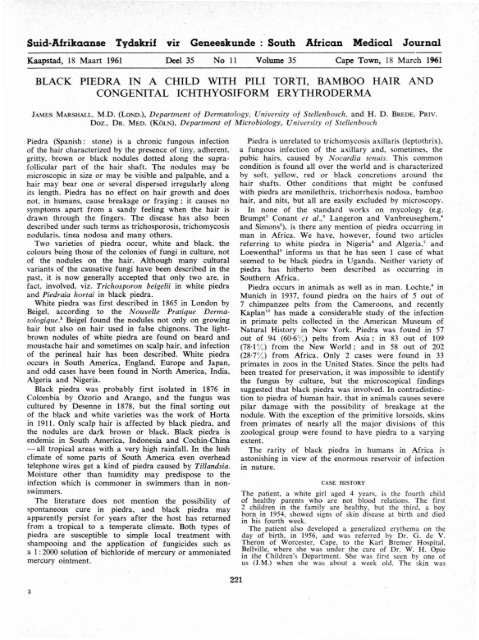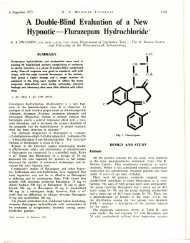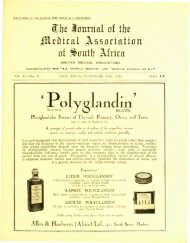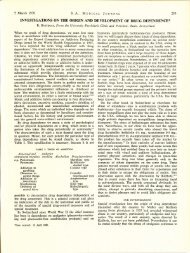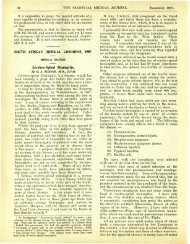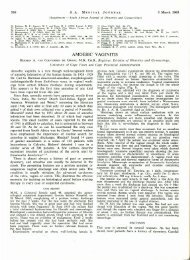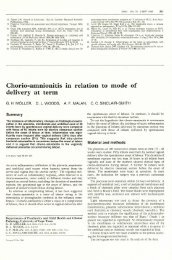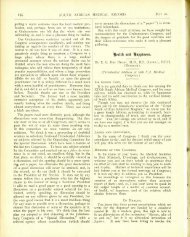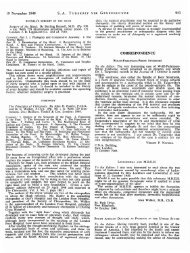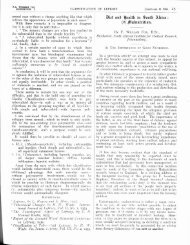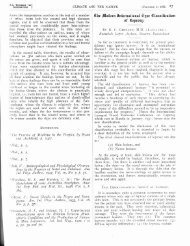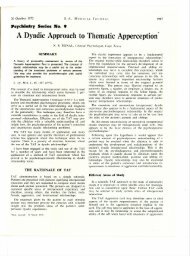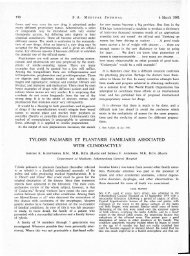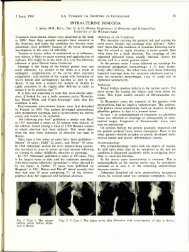3.1 BLACK PIEDRA IN A CHILD WITH PILI TORTI, BAMBOO HAIR ...
3.1 BLACK PIEDRA IN A CHILD WITH PILI TORTI, BAMBOO HAIR ...
3.1 BLACK PIEDRA IN A CHILD WITH PILI TORTI, BAMBOO HAIR ...
You also want an ePaper? Increase the reach of your titles
YUMPU automatically turns print PDFs into web optimized ePapers that Google loves.
Suid-Afrikaanse Tydskrif vu Geneeskunde: South African Medical Journal<br />
Kaapstad. 18 Maart 1961 Deel 35 No 11 Volume 35 Cape Town. I March 1961<br />
<strong>BLACK</strong> <strong>PIEDRA</strong> <strong>IN</strong> A <strong>CHILD</strong> <strong>WITH</strong> <strong>PILI</strong> <strong>TORTI</strong>, <strong>BAMBOO</strong> <strong>HAIR</strong> A D<br />
CO GENITAL ICHTHYOSIFORM ERYTHRODERMA<br />
JAMES MARSHALL, M.D. (LaND.), Department of Dermatology, University of Stellenbosch, and H. D. BREDE, PRIV.<br />
Doz., DR. MED. (KOL ), Department of Microbiology, University of Stellenbosch<br />
Piedra (Spanish: stone) is a chronic fungous infection<br />
of the hair characteriZed by the presence of tiny, adherent,<br />
gritty, brown or black nodules dotted along the suprafollicular<br />
part of the hair shaft. The nodules may be<br />
microscopic in size or may be visible and palpable, and a<br />
hair may bear one or several dispersed irregularly along<br />
its length. Piedra has no effect on hair growth and does<br />
not, in humans, cause breakage or fraying; it causes no<br />
symptoms apart from a sandy feeling when the hair is<br />
drawn through the fingers. The disease has also been<br />
described under such terms as trichosporosis, trichomycosis<br />
nodularis, tinea nodosa and many others.<br />
Two varieties of piedra occur, white and black, the<br />
colours being those of the colonies of fungi in culture, not<br />
of the nodules on the hair. Although many cultural<br />
variants of the causative fungi have been described in the<br />
past, it is now generally accepted that only two are, in<br />
fact, involved, viz. Trichosporon beigelii in white piedra<br />
and Piedraia hortai in black piedra.<br />
White piedra was first described in 1865 in London by<br />
Beigel, according to the Nouvelle Pratique Dermatologique?<br />
Beigel found the nodules not only on growing<br />
hair but also on hair used in false chignons. The lightbrown<br />
nodules of white piedra are found on beard and<br />
moustache hair and sometimes on scalp hair, and infection<br />
of the perineal hair has been described. White piedra<br />
occurs in South America, England, Europe and' Japan,<br />
and odd cases have been found in North America, India,<br />
Algeria and Nigeria.<br />
Black piedra was probably first isolated in 1876 in<br />
Colombia by Ozorio and Arango, and the fungus was<br />
cultured by Desenne in 1878, but the final sorting out<br />
of the black and white varieties was the work of Horta<br />
in 1911. Only scalp hair is affected by black piedra, and<br />
the nodules are dark brown or black. Black piedra is<br />
endemic in South America, Indonesia and Cochin-China<br />
- all tropical areas with a very high rainfall. In the lush<br />
climate of some parts of South America even overhead<br />
telephone wires get a kind of piedra caused by Tillandsia.<br />
Moisture other than humidity may predispose to the<br />
infection which is commoner in swimmers than in nonswimmers.<br />
The literature does not mention the possibility of<br />
spontaneous cure in piedra, and black piedra may<br />
apparently persist for years after the host has returned<br />
from a tropical to a temperate climate. Both types of<br />
piedra are susceptible to simple local treatment with<br />
shampooing and the application of fungicides such as<br />
a 1: 2000 solution of bichloride of mercury or ammoniated<br />
mercury ointment.<br />
3<br />
221<br />
Piedra is unrelated to trichomycosis axillari (leptothrix),<br />
a fungous infection of the axillary and, sometimes, the<br />
pubic hairs caused by ocardia tenuis. This common<br />
condition is found all over the world and is characterized<br />
by oft, yellow, red or black concretions around the<br />
hair shafts. Other conditions that might be confu ed<br />
with piedra are monilethrix, trichorrhexis nodo a, bamboo<br />
hair, and nits, but all are easily excluded by micro copy.<br />
In none of the standard works on mycology (e.g.<br />
Brumpt' Conant et al.,' Langeron and Vanbreuseghem;<br />
and Simons 5 ), is there any mention of piedra occurring in<br />
man in Africa. We have, however, found two articles<br />
referring to white piedra in Nigeria" and Algeria,7 and<br />
Loewenthal 8 informs us that he has seen 1 case of what<br />
seemed to be black piedra in Uganda. either variety of<br />
piedra has hitherto been described as occurring in<br />
Southern Africa.<br />
Piedra occurs in animals as well as in man. Lochte," in<br />
Munich in 1937, found piedra on the hairs of 5 out of<br />
7 chimpanzee pelts from the Cameroons, and recently<br />
Kaplan 'o has made a considerable study of the infection<br />
in primate pelts collected in the American Museum of<br />
Natural History in ew York. Piedra was found in 57<br />
out of 94 (60,6%) pelts from Asia; in 83 out of 109<br />
(78'1 %) from the New World; and in 58 out of 202<br />
(28,7%) from Africa. Only 2 cases were found in 33<br />
primates in zoos in the United States. Since the pelts had<br />
been treated for preservation, it was impossible to identify<br />
the fungus by culture, but the rnicroscopical findings<br />
suggested that black piedra was involved. In contradistinction<br />
to piedra of human hair, that in animals causes severe<br />
pilar damage with the possibility of breakage at the<br />
nodule. With the exception of the primitive lorsoids, skins<br />
from primates of nearly all the major divisions of this<br />
zoological group were found to have piedra to a varying<br />
extent.<br />
The rarity of black piedra in humans in Africa i<br />
astonishing in view of the enormous reservoir of infection<br />
in nature.<br />
CASE HISTORY<br />
The patient, a white girl aged 4 years, is the fourth child<br />
of healthy parents who are not blood relation. The fir t<br />
2 children in the family are healthy, but the third, a boy<br />
bom in 1954, howed signs of kin disea e at birth and died<br />
in his fourth week.<br />
The patient also developed a generalized erythema on the<br />
day of birth, in 1956, and was referred by Dr. G. de V.<br />
Theron of Worcester, Cape, to the Karl Bremer Hospital,<br />
Bellville, where he wa under the care of Dr. W. H. Opie<br />
in the Children's Department. She was first seen by one of<br />
us (J.M.) when he was about a week old. The skin wa
222<br />
generally erythematou and there was a typical widespread<br />
moniliasis of the skin and the buccal mucosa. Her general<br />
condition cau ed no concern. The monilial infection cleared<br />
slowly on treatment with 'mycostatin' and the last remnant<br />
disappeared only when she wa about 9 months old. At this<br />
time the skin remained a little pink.<br />
She was nOI seen again until 1960. In the interval the skin<br />
had become red, scaly and itchy, especially in the flexures.<br />
The hair eemed normal at birth but it had soon fallen out<br />
in patches until the scalp was denuded; the calp had<br />
always shown fine superficial caling. Until the age of 2 years<br />
there was little scalp hair, but thereafter she had grown a<br />
hort stubble over the back of the head and rather longer<br />
hair in front.<br />
In 1960 she was small for her age, but active and intelligent.<br />
The skin was generally a little erythematous and scaly. The<br />
erythema was said to vary in intensity and to be occasionally<br />
blotchy. Scaling was most marked in the flexures of the<br />
elbows and knees, and there wa a fine desquamation of the<br />
calp. Follicular keratosis was not noted. On the limbs,<br />
particularly the legs, there were rings of superficial scaling,<br />
some showing concentric figures; a few such lesions were seen<br />
on the trunk (Fig. 1). These rings came and went continually.<br />
There was superficial peeling of the fingers and toes, but no<br />
palmo-plantar hyperkeratosis. No vesicular or bullous lesions<br />
were seen. Secondary coccal infection was obvious about<br />
the ears and in the natal cleft, and there was a chronic<br />
blepharitis. The teeth and nails were normal. There were no<br />
defects in vision, hearing or intellect, and sweating appeared<br />
normal. The skin state was one of congenital ichthyosiform<br />
erythroderma.<br />
From a description given by Dr. G. de V. Theron it seems<br />
likely that the brother who died suffered from the same<br />
genodermatosis. The other members of the family show no<br />
abnormalities of the skin or epidermal appendages.<br />
Fig. 1. Back .of leg showing intertrigo and circinate scaling.<br />
S.A. MEDICAL JOURNAL<br />
18 March 1961<br />
The patient's scalp hair was short, coarse, dry, dull and<br />
sparse; at the back of the head the hairs were about 1 cm.<br />
in length, in front about 5 cm. (Fig. 2). Tiny nodular swellings<br />
were vi ible on most of the short hairs and on some of the<br />
longer hairs. The eyebrow hairs and eyelashes were scanty<br />
and bore nodules. Body hair was almost non-existent.<br />
aked-eye examination uggested piedra and hairs were<br />
taken for mycological studies, but microscopic examination<br />
showed that although some of the nodules were piedra<br />
concretions most were bamboo hair swellings, and that yet<br />
another abnormality, pili torti, was also present.<br />
Mycology<br />
Some of the hairs received for fungus studies showed small<br />
black, hard nodules containing dark, branching hyphae<br />
re embling arthro pores and small asci with several fusiform<br />
a cospores. The hair shafts themselves were not invaded.<br />
Material was planted on Littman's oxgall agar and on<br />
Sabouraud's agar. Most of the nodules gave no growth, but<br />
a few produced slow-growing, greenish-black, wrinkled<br />
colonies that were fully developed after 22 days. Growth was<br />
better on Sabouraud's than on Littman's medium (Figs. 3 - 6).<br />
The piedra concretion is decomposed by treatment with 10%<br />
potassium hydroxide for 10 - 15 minutes. It is then obvious<br />
that the nodule is composed of closely septate, branched<br />
hyphae, 4 - 8 p. in diameter, held together by a cement-like<br />
substance. In this case the fungus was clearly ectothrix.<br />
Both microscopically and culturally the fungus grown wa<br />
identical with that described as Piedraia hortai.<br />
A fortnight after the child had finished a month's course of<br />
gri eofulvin (0·5 g. daily), hairs were agaJn planted on agar<br />
and a growth of P. hortai was obtained. The patient's father,<br />
mother, brother and sister showed no clinical or microscopical<br />
evidence of piedra, but hairs were planted on agar and in<br />
the case of the sister P. hortai was cultured on one occasion.<br />
Fig. 2. Stubbly hair on scalp.
18 Maart 1961 S.A. TYDSKRIF VIR GE EESKU DE 223<br />
Fig. 3. Piedraia hortai growing on Sabouraud's agar (24th day). One<br />
of we hairs to the left of the colony bears a piedra nodule.<br />
Fig. 5. Invasion of cuticle revealed by removal of piedra nodule.<br />
Bamboo Hair<br />
DISCUSSION<br />
Bamboo hair was the excellent term chosen by<br />
Netherton" to describe a unique variety of trichorrhexis<br />
nodosa that he found in a girl with congenital ichthyosiform<br />
erythroderma. The nodules were found, in his case,<br />
on scalp hair, eyebrows, eyelashes and body hair, and<br />
the changes he describes are precisely the same as those in<br />
our patient's hair. In etherton's case there was no<br />
torsion of the hair shafts deserving the description of pili<br />
torti, and cultures for fungi were sterile.<br />
The nodular swellings, which are clearly visible under<br />
a hand len , are dotted irregularly along the hair shaft and<br />
may be single or multiple. The abnormality is most frequently<br />
found on the shortest hairs, but is sometimes<br />
found on longer hairs. There is great variation in the<br />
diameter of the hairs. The largest nodules consist of a<br />
cup- haped swelling or socket on the proximal part of the<br />
hair shaft into which the distal shaft is inserted, giving<br />
an appearance reminiscent of an impacted fracture, and<br />
a hair dotted with nodules looks just like a bamboo rod.<br />
Breakage of hair occurs at such nodules and most often<br />
Fig. 4. Piedra nodule attached to hair shaft.<br />
Fig. 6. Ascospores in piedra nodule after maceration in potassium<br />
hydroxide.<br />
leaves a clean socket on the proximal shaft; occasionally<br />
a socket is left with a splinter of the distal shaft still<br />
emerging: from it (Figs. 7 and 8). The least degree of<br />
abnorlPality in the hairs is manifested by ainhum-like<br />
constrictions of the shaft, and all grades of abnormality<br />
between simple sulcation and the final socket formations<br />
can be found (Fig. 9).<br />
Many hairs show medullary degeneration manifested by<br />
collections of black granules. These show on the illustrations<br />
only as dark central masses. etherton found a dense<br />
concentration of these granules in the socket formations,<br />
but this was not a notable feature in our case. We agree<br />
with Tetherton that bamboo hair is a congenital defect<br />
and not due to any infective proce s in the hair haft.<br />
Apart from etherton's original case and ours only one<br />
other has been found. etherton U inform us that Dr.<br />
G. Curtis, in the USA, ha found a girl with bamboo hair<br />
and a history identical with that in hi own case.<br />
The defect in bamboo hair i entirely different from<br />
that in classical trichorrhexi nodo a. In this fairly common<br />
condition the nodules on the hair shafts are caused<br />
by longitudinal splitting and the appearance was compared<br />
by Sabouraud 13 to that een in 'a piece of wicker<br />
6
224 S.A. MEDICAL JOURNAL 18 March 1961<br />
10<br />
Fig. 7. Bamboo hair. Typical fully developed nodule and<br />
terminal socket. The other hair shows medullary degeneration<br />
and torsion.<br />
Fig. 10. Pili torti. The irregular twisting of pili torti<br />
contrasted with the regular beading of monilethrix (on<br />
the right).<br />
that has been bent back and forth a hundred times at the<br />
same point', and when a hair fractures the broken ends<br />
look like brooms. Trichorrhexis nodosa is usually caused<br />
by chemical or physical trauma to the hair (e.g. too<br />
frequent shampooing, bleaches, violent brushing), but<br />
Touraine H mentions some families in which the tendency<br />
is inherited in dominance.<br />
etherton U entitled his article 'A unique case of<br />
trichorrhexis nodosa - "Bamboo hairs" '.In order to-avoid<br />
confusing 2 disparate conditions we believe bamboo hair<br />
should be so described tout court, and trichorrhexis nodosa<br />
reserved for the commoner state that has for long borne<br />
this name.<br />
Pili torti<br />
Pili torti (trichokinesis, trichotortosis, twisted hair,<br />
woolly hair, gedrehte Haare) was another defect found in<br />
our case. In this condition the hair is flattened and presents<br />
from 3 to 10 torsions where the shaft twists through<br />
180 0 on its axis. Danforth 15 noted that normal hair is<br />
frequently ribbon-shaped rather than cylindrical and that<br />
torsion may occur, but in pili torti there are usually many<br />
twists in a given hair, and the hairs break easily. In our<br />
case most of the scalp and eyebrow hairs examined showed<br />
multiple twists, and many hairs had both twists and<br />
bamboo nodules.<br />
Pili tqrti has often occurred in families and is then<br />
inherited as a dominant trait. Among other abnormalities<br />
which have been found in patients with pili torti are<br />
milia of the face, keratosis follicularis and classical<br />
"<br />
II<br />
Fig. 8, Bamboo hair. Fully developed nodules and<br />
terminal socket.<br />
Fig. 9. Bamboo hair. Minor changes.<br />
trichorrhexis nodosa; ichthyosis has occurred in other<br />
members of the family of a sufferer. H In a case described<br />
by Bjornstad'· the twisted hairs were fluted with longitudinal<br />
ridges and fissures. A localized growth of twisted hair<br />
followed an infection of the scalp in a case reported by<br />
Scott.'" Children with pili torti are often born with little<br />
or no scalp hair, and the abnormality may be recognized<br />
only after a year or two when a short stubble grows.<br />
In the majority of cases the hair on the occipital scalp<br />
is most affected. Twisted hairs are less elastic than normal<br />
and break easily with lengthwise splitting (trichoptilosis)<br />
leaving a broom-like end as in trichorrhexis nodosa.<br />
Breakage only rarely takes place at the first twist above<br />
the follicle. Twisting does not occur at regular intervals<br />
so that there is little likelihood of confusing pili torti with


